Lanyu, or Orchid Island, may be a place on Taiwan’s doorstep – two and a half hours by ferry from Taitung – but it is a world apart. Home to the Tao indigenous people, it has a culture, lifestyle, traditions, cuisine, and sense of time and space that is nothing like that on what the Tao call “the mainland.”
While waking through one of the villages on a recent island visit – my first, despite having lived in Taiwan 20-plus years – a travel companion who has been in Taiwan as long and was also on his first Lanyu foray suddenly turned to me and said:
“It’s like we’re in another world.”
I had at that moment been thinking just that. Here’s a highlights foundation that will prepare you for your own journey to “Lanyu world.”

The Place
Mountainous Lanyu is a big cooled chunk of lava, outlined with some of Taiwan’s most dive-worthy coral reef, that was long ago spewed forth from ocean’s bottom (don’t worry, Mother Nature has gone into a deep slumber here). Measuring 45.7 sq. km., the Polynesia-like island, covered in tropical rainforest, bobs up and down in deep-blue ocean waters about 90 kilometers southeast of the city of Taitung, on Taiwan proper’s southeast coast (at least, it seems to bob when the Pacific is less than pacific, which is often).

Isolated from Taiwan’s main island geographically, Lanyu was also long cut off from it economically, though tourism has today become the main money-maker for locals. There is virtually no local industry. During the 1895~1945 period of Japanese colonial rule of Taiwan, officials from Nippon made the remote island a living museum for anthropological study, cutting it off from all but approved academics and administrators. The Tao at the time were the only residents. Today, the island offers near-perfect conditions for the traveler looking for a safe destination almost untainted by mass consumer culture.
The People
The Tao number about 3,000 (there are also about 1,000 Han Chinese residents on the island). They are members of the great Austronesian diaspora and evidence indicates that they reached this idyllic island abode less than a thousand years ago. Clear clues from their mythology, as well as from linguistic studies, point to the Philippines’ Batanes islands as their jumping-off point; the Batanes cluster sits in the Bashi Channel between Taiwan and Luzon.

The name Tao simply means “the people,” and they call their home “Pongso no Tao” (“Island of the People”). Mistakenly labeled the Yami people by a Japanese anthropologist – “Yami” means “northern islanders” – today locals will inevitably refer to themselves as Tao, but accept the use of Yami by others. The name Orchid Island was bestowed by the Republic of China government; today not too many of the once thriving butterfly orchids in question are left, save in the deep hills.
Round-Island Travel
Travel around the island is via a paved loop road that hugs the coastline. There is also a winding road serving up lovely vistas that crosses the mountains between the villages of Hongtou and Yeyin. The island’s six villages are all located along the loop road, which stretches 37.5 kilometers in total. The best way to travel about is to rent a scooter, and the best and most convenient location for this is the rental station beside the only gas station on the island at Kaiyuan Harbor, where the ferries dock. Local homestay and inn operators will also help with rentals. The cost is NT$400-500 per day, gas not included.
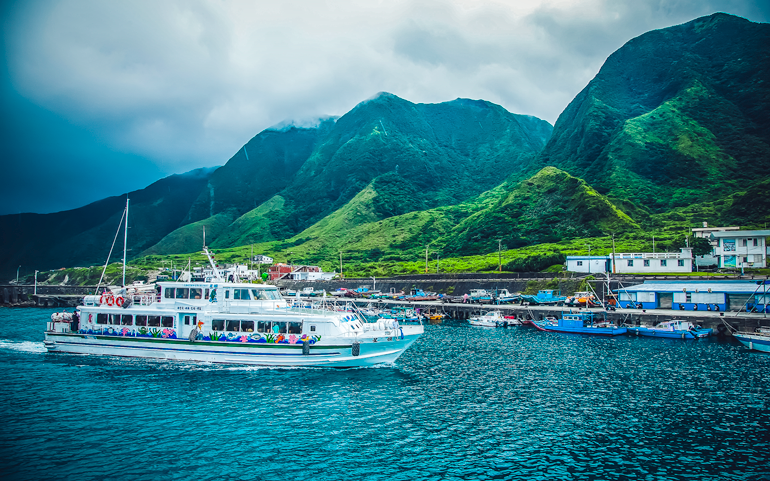
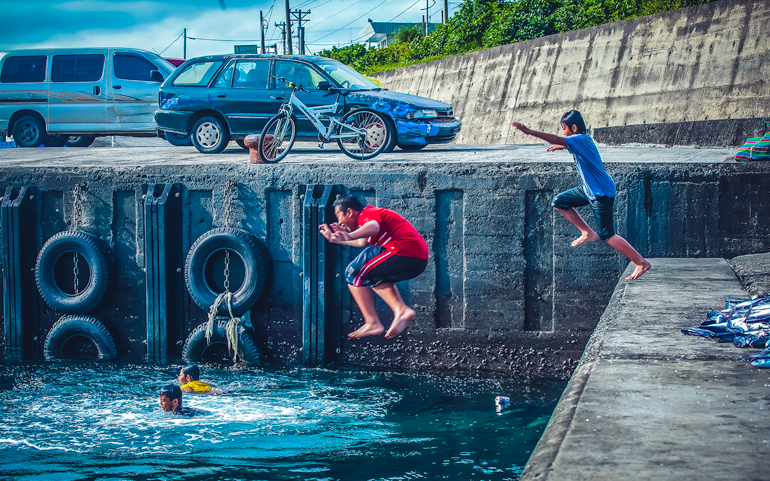
Note that the loop road, generally in good shape, has some rough patches. Also note that goats, pigs, chickens, dogs, and cats roam the roads freely, and that island seniors tend to make sudden direction changes when driving scooters/motorbikes, so keep an eye out.
Traditional Tao Canoes
One of Lanyu’s most iconic sights is the collections of colorful traditional Tao canoes pulled up on the beaches before the villages. The simple tools their forefathers used are still largely relied on today to build the renowned, richly decorated traditional Tao seagoing canoe, made from 27 separate configurations carved from wood, which are fastened snugly together with pegs. No nails. The launching of a finished canoe is enmeshed in solemn age-old ritual and much celebrating.
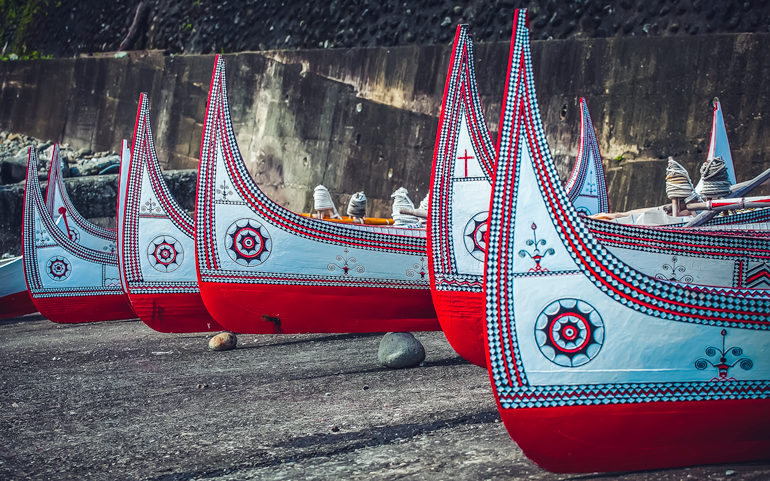
Traditional Tao Dwellings
The other key Tao-culture visual is the tribe’s unique traditional architecture. The number of these dwellings is steadily dwindling, but a large cluster remains in Yeyin. (Note that a great bird’s-eye photo-opp view of the cluster is enjoyed from the cross-island mountain road.)

The eye-catching semi-subterranean dwellings, very much still functioning homes, are made of stone, wood, and thatch. Built low to offer protection against heat and typhoons, they stay cool in summer and retain heat in winter. A simple workhouse of smaller size is constructed on one side; each has a plank floor and a below-ground storage space underneath. On the other side is an elevated rest platform, capped with a sun-shield thatch roof, which catches cooling breezes. These inevitably have a grand, unobstructed view of the sea, and are a favorite place to sit about gnawing over the issues of the day and perhaps a chew of betel-nut.

Rock Formations
The majesty of the mountain/ocean scenery is embellished further by the many large, striking rock formations you’ll come across when zooming around the coast. Each has had an imaginative name bestowed on it – Twin Lions Rock, Dragon Head Rock, Virgin Rock, and so on. Most visually compelling, I have found, are Battleship Rock, Lovers’ Cave, and Old Head Rock.

Battleship Rock has rocky spikes resembling gun turrets, and locals enjoy telling tourists the story that during WW II a Japanese ship attacked it, spotters mistaking it for a US naval craft.
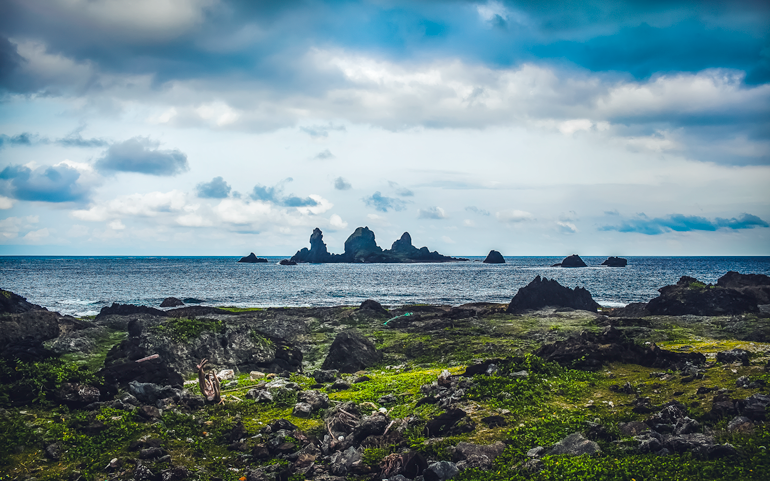
Lover’s Cave features a huge hole drilled right through a promontory by the pounding sea, which continues to drill relentlessly through the soaring cliff behind in a magnificent show of power against power.
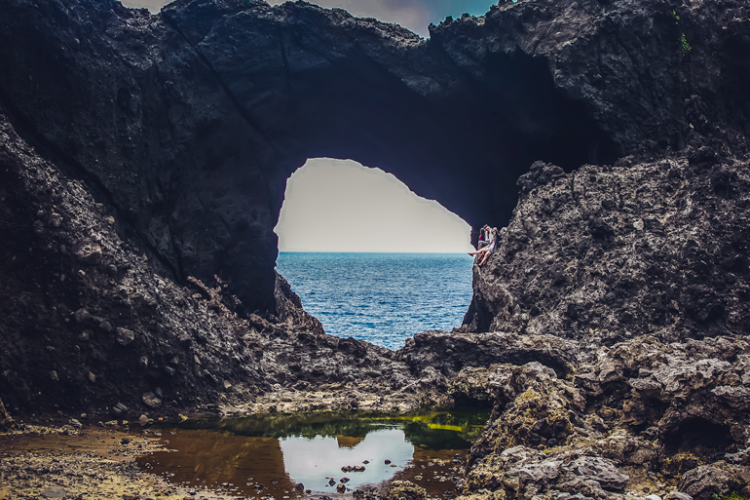
The Old Man Rock, carved out from solid cliff by surf and typhoon (with a giant cave dug out right behind), can be viewed from above at cliff-edge from the peaceful Green Green Grassland, which has an unfettered view of Little Lanyu island off in the distance, around which locals get most of their flying-fish catch.
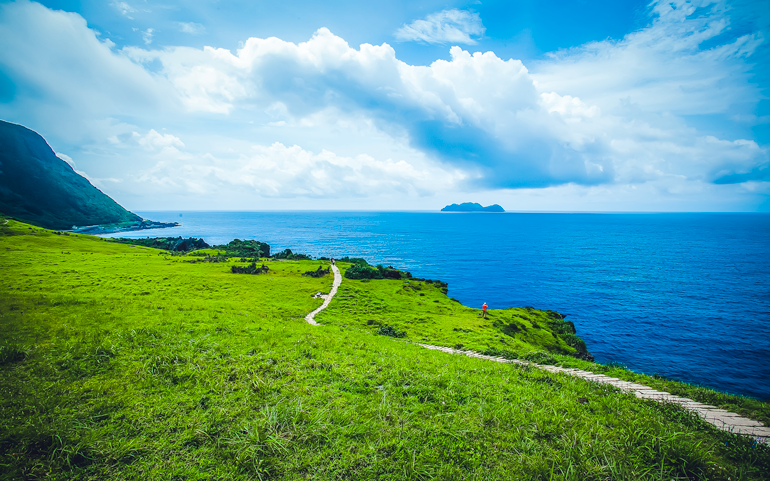
Sunrises/Sunsets
The Lanyu sunrises and sunsets are inspiring experiences, capturing the dramatically changing daily moods of the surrounding sea and sky. My vote for best sunrise-viewing spot is the mountaintop weather station (about 550 meters above sea level). Head up the cross-island mountain road, where near the highest point you’ll see a clearly marked turn-off. This short road is comparatively steep – don’t let the sweeping views distract you – and you’ll need to park and walk the last few hundred meters. The panorama over Dongqing Bay to the east is soaringly inspiring.

In my book, the best sunset views are along the coast from behind the giant offshore Mantou Rock (“Steamed Bun” Rock), either from pretty Yeyou Elementary School, decorated with Tao-icon imagery, or the higher promontory just south of here, visited daily at nightfall by a herd of goats who love striking dramatic poses in silhouette.
Snorkeling/Diving and Fish-Catching Experiences
The island has what many aficionados consider Taiwan’s best snorkeling and diving. Hotel and homestay operators can arrange guided outings (NT$400 per person without boat, NT$600 with, approx. 2 hours). Operators also arrange flying-fish view/catch excursions. The outings, in small, open, shallow-draft craft with experienced fishermen, are after sunset, when the fish come close to shore (NT$400 per person, 2-3 hours).
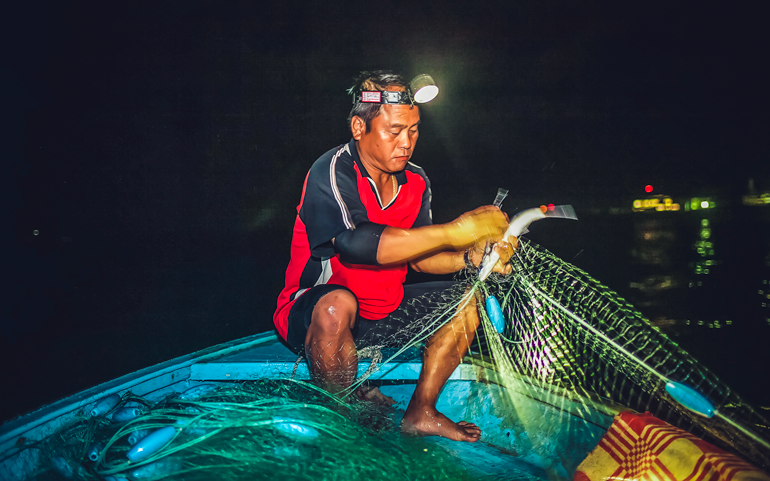
Diving in Lanyu
Taitung|Lanyu Landi Diving|Experience Diving
Cuisine
The three main Tao food staples are flying fish, taro, and yam. The fish is prepared in many ways, most commonly steamed, fried, and in soup. Flying-fish fried rice, made with sun-dried fish, is also quite tasty. Other recommended treats are the lightly sweetened Tao pie, which has the consistency of pumpkin pie, and the chilled taro balls, as soft as ice cream on the outside. The best Tao food is served at the island’s best (and most relaxing) restaurant, the Epicurean Café in Yuren.
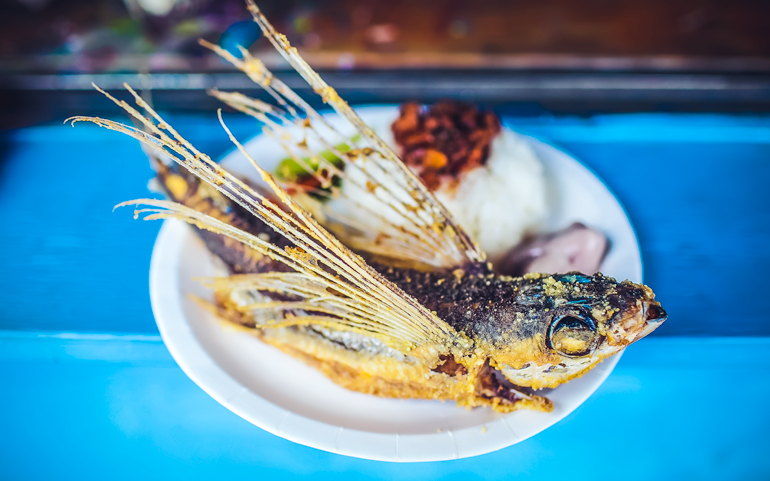
Arts & Crafts
There are a number of shops and studios where Tao-theme items crafted by island artisans are sold. Perhaps most attractive to the tourist are the brightly painted models of the traditional canoes. Specially recommended is the shop at the Lan En Cultural Gallery in Yuren, which also has an interesting display of Tao cultural artifacts and a full mock-up of a traditional Tao dwelling outside.

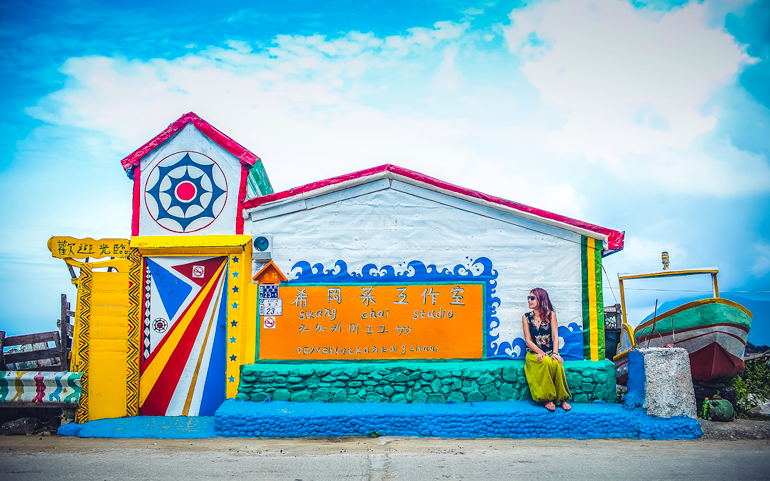
The “Action”
A trip to Lanyu should be – in fact must be, for you’ve really no other choice – to slow down, unwind, and enjoy Mother Nature’s art. The only real nightlife in the sleepy villages is in Hongtou, where bright lights illuminate the cluster of brightly painted tourist-oriented gift shops and eateries-cum-cafes-cum-pubs at night. Note as well that the only gas station is at Kaiyuan Harbor, and that the number of convenience stores, none chain-owned, is limited – so don’t leave your goodies-shopping too late each day.

The Flying Fish Festival
Traditional Tao belief is that fire was long ago stolen from a strange goat-headed people living under the island. A young Tao accidentally found them after traversing a long tunnel. These people also told him how to catch flying fish, and which types to catch in which season, thus preserving stock.

Beyond new-canoe launching, the annual Flying Fish Festival is the other major Tao celebration, featuring rich pomp and ritual. With the start of the main flying-fish season in spring, the fish ride the Japan Current north in huge schools. The men don their traditional ritual dress of loincloth, rattan-vest armor, and silver conical helmet. Besides his canoe, the helmet is the Tao man’s most cherished possession. Covering the entire head, with slits left for the eyes, the helmets, made in days of yore with silver from Spanish and Japanese coins beaten into strips – the Tao did not smelt metal – are only seen on special days. The coins were acquired in the days of sail through trade with passing craft, salvaging of sunken craft, dealing with the people of the Batanes, and sometimes through raids.
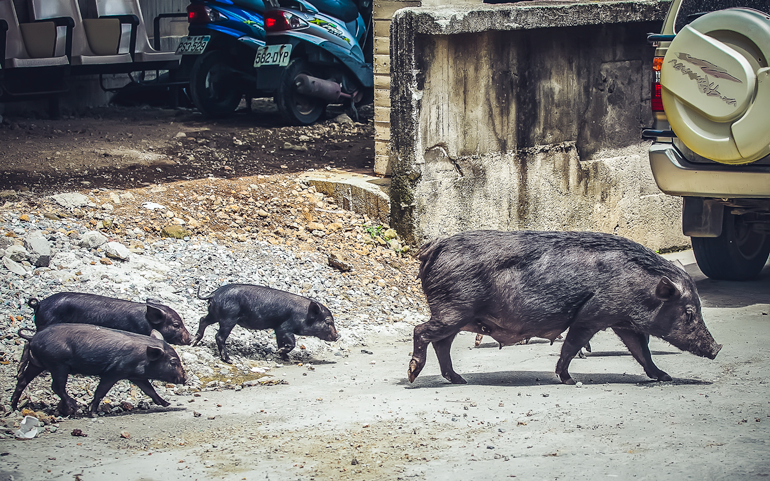

Typical street scene II
Getting There & Getting Around
There is a daily ferry service from Fugang Harbor, just north of Taitung City (90~120 minutes one way), and from Houbitou in Kenting National Park. Ferries from both locations dock at Kaiyuan Harbor. Bring along seasickness pills; at Fugang Harbor, these can be purchased at the terminal’s convenience store. There are also a number of flights daily from Taitung Airport (20 minutes one way), operated by Daily Air (www.dailyair.com.tw). The planes are small, and seats fill up quickly, so book well ahead. Note that air and ferry service is often cancelled because of inclement weather.

Further reading on other sites:
SPIRITUAL TRAVELS: Orchid Island, Taiwan: A Detailed 2019 Guide
FOREIGNERS IN TAIWAN: Orchid Island – Ponso no Tao (Lanyu)
MEL B TRAVEL: What to see and do on Green Island Taiwan
About the author

Rick Charette
A Canadian, Rick has been resident in Taiwan almost continually since 1988. His book, article, and other writings, on Asian and North American destinations and subjects—encompassing travel, culture, history, business/economics—have been published widely overseas and in Taiwan. He has worked with National Geographic, Michelin, APA Insight Guides, and other Western groups internationally, and with many local publishers and central/city/county government bodies in Taiwan. Rick also handles a wide range of editorial and translation (from Mandarin Chinese) projects.















